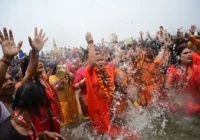India, a nation with more than 1.3 billion people and a constitutional commitment to a multicultural society, is struggling with the definition of “people.” The Daily Devil’s Dictionary explains.
With a general election approaching, India has been focusing its attention on what the prime minister, Narendra Modi, represents for voters. Will his Bharatiya Janata Party (BJP) win another landslide victory, which would confirm Modi’s sense of his own authority? Or will serious disappointment with his performance as prime minister lead to a hung parliament? Where would that leave Modi as a leader?
But there are other more serious questions facing India than the impact of the election on Modi’s image. What effect will the result have on growing tensions between Hindus and Muslims?
Hindu nationalism played an important part in the BJP’s triumph in 2014. Just as Donald Trump’s election in the US encouraged the white supremacists who had been marginalized and shamed by previous administrations, Modi’s rise to leadership empowered those who see India’s Muslims as internal enemies of the Hindu religion and culture. Although the seeds of today’s increasingly tense communal conflict existed at the time of India’s independence, and were amplified by the British, the democratic principles written into the Indian Constitution clearly aimed at the establishment of a multicultural society.
Citing the social activist Shabnam Hashmi, The South China Morning Post recounts the recent history of what it calls today’s “communal fever.” It adds that: “Islamophobia has broadened to encompass growing hatred and intolerance towards anybody who questions the government. Artists, intellectuals and journalists are branded anti-national and attacked and trolled mercilessly.”
Here is today’s 3D definition:
Anti-national:
Anyone in any way different from those who believe their group represents the nation. Treasonous.
Contextual note
National identity has become the major and increasingly unmanageable issue of democracies across the globe, as has become evident in the UK (Brexit), the US (white supremacy encouraged by Trump) and even more obviously in Israel, but also in India, China, Hungary and elsewhere.
At the core of this phenomenon is the largely unjustifiable belief that, in a modern democracy, a quality called “national identity” exists as a fixed attribute of real people. In traditional European monarchies before the age of democracy, people living within a realm or outside it willingly equated the identity of the monarch with the “body politic,” which stretched outwards from the king’s person to include all the people under the sovereign’s authority.
The theory of the “King’s Two bodies” — starting from the physical body of the king (“the Body natural”) — projected an idea of collective identity with the nation’s laws and customs (“the Body corporate”). The first body was mortal; the other immaterial and intangible. The king could act as a decision-maker but symbolically incorporated in his own being the life and the character of the entire community.
Democracy instituted a different symbolic order, turning the logic of monarchy on its head. The government and its leaders became an emanation of the body politic, which was defined as the entire population. Most people would spontaneously agree with Abraham Lincoln’s pithy description of democracy: “[A] government of the people, by the people and for the people.”
The problem then becomes how to think about the definition of “people.” Is it a majority of voters in an election? Is it an idealized “standard” citizen, who obeys the laws and respects the customs of the community and who may be mass produced by the educational system? Or is it a certain configuration of cultural traits — religion, ethnicity, class — that some consider “normal” for real or imaginary historical reasons and then attempt to impose their idea of normality on others?
Even the notion of a standard citizen — who “respects the customs of the community” — raises a serious question. What is the community?
What we are seeing across the globe today, in nations where the citizens elect their governments, is growing uncertainty about what the political leaders themselves think about the question of what constitutes “the people” and “the community.” Donald Trump and Narendra Modi are two examples of this, playing with concepts they cannot control.
Historical note
Jawaharlal Nehru’s India adopted a constitution that attempted to solve the problem posed by a heterogeneous population. It did so by acknowledging the diversity of communal identities. Manmohan Malhoutra writes: “The Rule of Law prescribed by the constitution co-exists with a variety of traditional personal laws for Muslims, Hindus and numerous tribal communities. For the Muslims, in particular, Islamic personal law is a significant badge of identity which no government has felt able to touch.”
 Shashi Tharoor, a controversial Indian National Congress MP who identifies as a Hindu, designated the historical source of today’s tensions: “The creation and perpetuation of Hindu-Muslim antagonism was the most significant accomplishment of British imperial policy: the colonial project of ‘divide et impera’ (divide and rule) fomented religious antagonisms to facilitate continued imperial rule and reached its tragic culmination in 1947.”
Shashi Tharoor, a controversial Indian National Congress MP who identifies as a Hindu, designated the historical source of today’s tensions: “The creation and perpetuation of Hindu-Muslim antagonism was the most significant accomplishment of British imperial policy: the colonial project of ‘divide et impera’ (divide and rule) fomented religious antagonisms to facilitate continued imperial rule and reached its tragic culmination in 1947.”
Tharoor points out that it was the British who created the idea that Hindus and Muslims were “monolithic communities.” Under the authority of the egregiously incompetent Lord Mountbatten, the British subsequently put into practice what they believed was a rational division of the former British Raj into the two “monolithic” cultures by drawing the absurd borders between India and Pakistan (including East Pakistan, now Bangladesh).
Modi came to power through the curiously combined effect of two factors: his success as chief minister of Gujarat in developing the local economy and his commitment to militant Hindu nationalism, concretized for the public by his actions in the 2002 Gujarat riots. To ensure his election and affirm his authority, he added a third factor by boasting (albeit indirectly) of having a 56-inch chest.
Is Narendra Modi the Donald Trump of India, who will be remembered more for his egotism and narcissism than for his half-baked economic reforms? If the BJP maintains its majority — or even if it loses it — will exacerbated communal tensions tear India apart? And beyond India, does this correspond to a global trend? Brexit has divided the UK, perhaps irreparably, into two curiously defined communities, where L and R no longer mean left and right, but leave and remain. To gain an electoral advantage, Trump has leveraged the existential doubt (and potential anger) of white Americans as their numerical majority keeps dwindling. Is this the prelude to a new civil war, but this time even messier because it’s not between two regions?
All eyes are on Brexit, even now that the sell-by date of March 29 has officially passed. All eyes will then turn not only to India in May, but also to the European elections and then on to the 2020 US presidential election, which is already heating up 18 months ahead of time.
And, in the background, it’s the stability of the idea of national democracy that is at stake and risks becoming unsustainable.
*[In the age of Oscar Wilde and Mark Twain, another American wit, the journalist Ambrose Bierce, produced a series of satirical definitions of commonly used terms, throwing light on their hidden meanings in real discourse. Bierce eventually collected and published them as a book, The Devil’s Dictionary, in 1911. We have shamelessly appropriated his title in the interest of continuing his wholesome pedagogical effort to enlighten generations of readers of the news.]
The views expressed in this article are the author’s own and do not necessarily reflect Fair Observer’s editorial policy.
Support Fair Observer
We rely on your support for our independence, diversity and quality.
For more than 10 years, Fair Observer has been free, fair and independent. No billionaire owns us, no advertisers control us. We are a reader-supported nonprofit. Unlike many other publications, we keep our content free for readers regardless of where they live or whether they can afford to pay. We have no paywalls and no ads.
In the post-truth era of fake news, echo chambers and filter bubbles, we publish a plurality of perspectives from around the world. Anyone can publish with us, but everyone goes through a rigorous editorial process. So, you get fact-checked, well-reasoned content instead of noise.
We publish 2,500+ voices from 90+ countries. We also conduct education and training programs
on subjects ranging from digital media and journalism to writing and critical thinking. This
doesn’t come cheap. Servers, editors, trainers and web developers cost
money.
Please consider supporting us on a regular basis as a recurring donor or a
sustaining member.
Will you support FO’s journalism?
We rely on your support for our independence, diversity and quality.






